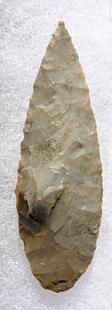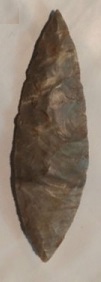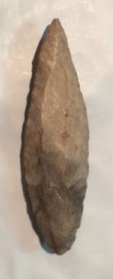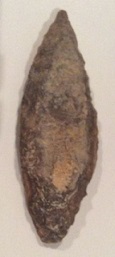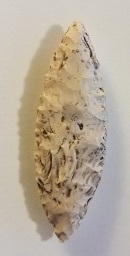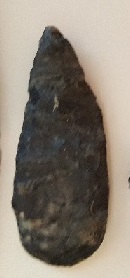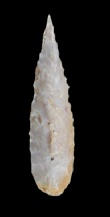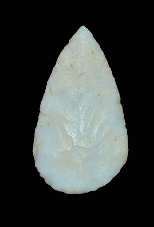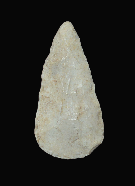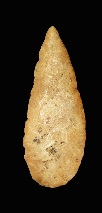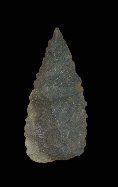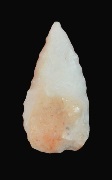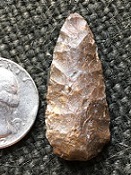Outline is Representative of Size and Shape:
 Nodena Banks
Nodena Banks
 Nodena Elliptical
Nodena Elliptical
 Nodena Banks
Nodena Banks
Name Details:
Identifd By: Carl Chapman and Lee Anderson (elliptical) / Gregory Perino (Banks)
Named For: Type Site
Date Identified: 1955 / 1966
Type Site: Nodena Site, eastern Arkansas and the Campbell site, Pemiscot County, Missouri /
Banks site, Crittenden County, Arkansas
Identifd By: Carl Chapman and Lee Anderson (elliptical) / Gregory Perino (Banks)
Named For: Type Site
Date Identified: 1955 / 1966
Type Site: Nodena Site, eastern Arkansas and the Campbell site, Pemiscot County, Missouri /
Banks site, Crittenden County, Arkansas
Point Validity:
Valid type
Chapman was a pioneering anthropologist and professor emeritus for the Department of Anthropology at the University of Missouri. Anderson is a distinguished anthropologist and professor for the Department of Anthropology at the University of Tennessee. They have both conducted extensive studies into the archaeology of the Mississippi River valley and especially Missouri. This type was named in a professional publication and has many professional references. This is considered a valid type
Chapman was a pioneering anthropologist and professor emeritus for the Department of Anthropology at the University of Missouri. Anderson is a distinguished anthropologist and professor for the Department of Anthropology at the University of Tennessee. They have both conducted extensive studies into the archaeology of the Mississippi River valley and especially Missouri. This type was named in a professional publication and has many professional references. This is considered a valid type
Nodena / Nodena Banks
AKA: Willow LeafCluster: Nodena Cluster
Description of Physical Characteristics and Flaking Pattern:
This is a thick medium (typically 1.25 to 2 inches) ovoid point with an elliptical cross section or a median ridge.. The blade is slender and excurvate with the widest part of the blade being at the midpoint to bottom third of the blade. The base may vary from convex to pointed for the Nodena Elliptical variant which gives the point a bi-point or teardrop appearance. The base may be straight for the Nodena Banks variant. This point commonly has a high degree of workmanship and is manufactured using a thin flake using fine pressure flaking forming a random, but some examples have had collateral or oblique transverse flaking.
Size Measurements:
Total Length - 30 to 80 mm, (average 55 to 65 for Elliptical and 40 to 50 mm for Banks), Width - 11 to 25 mm
Total Length - 30 to 80 mm, (average 55 to 65 for Elliptical and 40 to 50 mm for Banks), Width - 11 to 25 mm
Commonly Utilized Material:
High quality and exotic flints and cherts.
High quality and exotic flints and cherts.
Additional Comments:
Quapaw sites in Arkansas produce a high number of these points.
This point has also been referred to as the Willow Leaf point in some older publications and by collectors.
The Nodena Banks Variety is used to distinguish the straight base variant of the Nodena point (Justice, 1987).
Quapaw sites in Arkansas produce a high number of these points.
This point has also been referred to as the Willow Leaf point in some older publications and by collectors.
The Nodena Banks Variety is used to distinguish the straight base variant of the Nodena point (Justice, 1987).
Distribution: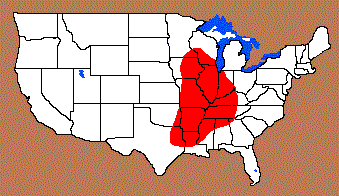
Distribution Comments:
The heaviest distributions are the lower Arkansas River Valley, St. Francis River Valley, the lower and mid Mississippi River valley, and into the Illinois River valley and Tennessee River valley. May be found with less frequency in other highlighted areas.
The heaviest distributions are the lower Arkansas River Valley, St. Francis River Valley, the lower and mid Mississippi River valley, and into the Illinois River valley and Tennessee River valley. May be found with less frequency in other highlighted areas.
Age / Periods:
Date: 600 - 400 B.P.
Cultural Period:Late Mississippian
Glacial Period: Little Ice Age
Culture: Quapaw Culture
Date: 600 - 400 B.P.
Cultural Period:Late Mississippian
Glacial Period: Little Ice Age
Culture: Quapaw Culture
Age Details:
This point is most commonly associated with the Menard, Parkin, and Wall-Pecan Point Focus, but may be as early as the New Madrid Focus (Bell, 1958)
This point is most commonly associated with the Menard, Parkin, and Wall-Pecan Point Focus, but may be as early as the New Madrid Focus (Bell, 1958)



